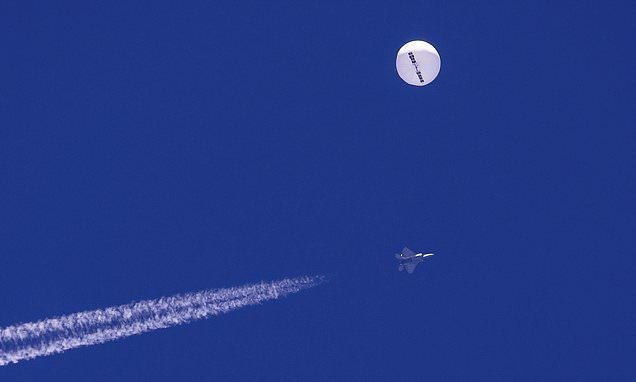with MARK ALMOND leading the charge.
There was something odd about China’s high-altitude balloon that traveled over America last week before being shot down by US Air Force F22 jets.
For six days, the lumbering airship hovered some 50,000 feet above the world’s greatest superpower and reportedly even traveled over Alaska without being detected.
In an age of advanced satellite communications, Star Wars-style missile defense, early warning systems, and laser-guided missiles, this was a machine that would have seemed dated to the Wright brothers, American aviation pioneers of the early 20th century.
Beijing’s spy balloon was able to circle major US surveillance programs precisely because it was so slow and primitive.
I believe the case has profound and far-reaching lessons – and we would do well to heed them.
Aggressive
The spy balloon floats over the Atlantic Ocean just off the coast of South Carolina on Saturday – with a fighter jet and its contrail below
This week the Mail drew attention to the precarious state of Britain’s defences. As the world grows ever more dangerous, with a revanchist Russia and an increasingly aggressive China destabilizing geopolitics, democracies have a clear need to retain powerful armed forces.
Several influential voices have called for a huge increase in UK military spending – and with good reason.
But while new tanks, jets, weapons, warships, ammunition and the rest are vital, the next world war – should it ever come – will be just as likely to be fought online as it is on the battlefield. Because of this, we must balance any spending on military hardware with massive investments in defense technology—that is, our ability to wage wars in cyberspace.
Just imagine a nightmare scenario in which the Chinese attach a small nuclear bomb to a second balloon and levitate it over the US – to detonate it over Chicago, say.
Given the weapon’s limited size, the blast itself may not cause much physical devastation or loss of life.
But its shockwaves could still cripple much of the electronic infrastructure in the eastern US.
Cell phones, Internet access, power grids, water supply, transportation networks, and military logistics would all be affected. Parts of society would cease to function.
This is the threat we should prepare for: investing in the technology and skills needed to detect and neutralize such attacks.
Britain is fortunate to have the world’s best intelligence and security apparatus at GCHQ in Cheltenham. But our systems are still too vulnerable to attacks by foreign regimes, criminal gangs and terrorists.
In recent months, the world has been dazzled by developments in artificial intelligence (AI). Programs like the remarkable machine learning software ChatGPT, which can answer many questions better and more coherently than humans, have hinted at the magnitude of this ability.
Another example is “deepfake” technology, where computers create eerily realistic videos of people seemingly saying things they would never say in real life.
These technologies are aimed at civilians. But you can be sure that our potential adversaries are studying how to use AI and other modern technologies in a future war. We should now match their investment pound by pound.
In recent months, the world has been dazzled by developments in artificial intelligence. Programs like the remarkable machine learning software ChatGPT, which can answer many questions better and more coherently than humans, have hinted at the magnitude of this ability
My point is that, as regular military procurement scandals demonstrate, wasting cash on huge projects is by itself no guarantee of effectiveness. Like the NHS, throwing money over them won’t solve problems.
The Ajax armored vehicle, for example, was supposed to enter service six years ago. The £5.5 billion project continues to face development and production issues.
Our overall approach over the past few years has been unbalanced, with too much money wasted on prestige initiatives while neglecting the fundamentals of defense.
All three ministries were downsized, but there was no corresponding pruning in higher hierarchies.
In 2019, the Ministry of Defense admitted the Royal Navy had 34 admirals – but only 20 warships. The higher ranks of the RAF are crammed with Air Vice Marshals, but the RAF as a whole has fewer operational aircraft than the average US aircraft carrier.
These people need to be much better deployed and better trained at all costs for the high-tech world of the 2020s.
The truth is that our armed forces have become complacent as the generals fought, or at least prepared for, the wars of the last century.
After the fall of the Soviet Union, the mistaken belief spread that Britain was no longer threatened by external threats – the world was witnessing what some called the “end of history”.
This led to the theory that our armed forces should be projecting British power overseas, rather than protecting us at home. The Army was to be redesigned into an elite, lean expeditionary force, just as the Royal Navy would command awe around the world with two massive new aircraft carriers that would cost a combined £7 billion.
It’s a strategy that has catastrophically backfired.
sabotage
The Royal Navy released images of HMS Portland pursuing Russian ships in the North Sea on January 9, 2023
Failed interventions in Iraq and Afghanistan have severely eroded Britain’s military reputation, while building the two aircraft carriers now looks like an act of epic folly.
One was plagued by technical problems and both had to use borrowed American aircraft because Britain does not have its own suitable seaplane.
The skewed priority given to carriers has left our defense spending hopelessly off balance. The Royal Navy now lacks sailors, submarines and ships to patrol the underwater infrastructure – like umbilicals and internet cables – around our coast.
Like a nuclear explosion triggered by a high-altitude balloon, a deliberate, sustained but deniable attack on this infrastructure by unknown attackers would cause social chaos and economic collapse. The sabotage of the Nord Stream gas pipeline last September was a warning shot in that regard – one that revealed our unpreparedness for such attacks.
And that leads me to another key question about how best to prepare for war in modern times. Often it is a question of proportions.
Former US President George W. Bush, a critic of Pentagon excesses, lamented the absurdity of aiming a $2 million rocket at “an empty $10 tent” and then “slamming a camel into the butt hitting,” as he put it.
The same disparity can be seen in the current Ukraine war, where Western anti-aircraft missiles, often costing over $250,000, are being fired against Iranian drones priced at just $5,000. Old-fashioned anti-aircraft guns could do the job just as well.
Danger
Air Chief Marshal Mike Wigston (left) and Station Commander for RAF Coningsby Billy Cooper (right) with Prime Minister Rishi Sunak during his visit to RAF Coningsby in Linconshire
We also need less “sophistication” in recruiting our defenses. The RAF’s emphasis on gender balance for their fighter pilots, for example, ignores the fact that the Typhoon helmet is too heavy for the average woman, no matter how committed.
This isn’t just a matter of redesign: the helmet’s built-in protectors and hi-tech components mean it will always be very heavy.
It is ridiculous that, as we learned this week, the RAF is struggling with staff shortages while at the same time turning down young, tough, capable men who want to do the job – simply because of their gender.
Some elements of war are timeless. As George Orwell warned, “We sleep soundly because rough men stand by at night to do violence to those who would harm us.”
It is therefore crucial that increased spending on military hardware is matched by far larger and more targeted investments in dealing with the types of attacks we are likely to face in the future – as well as in the spying skills that could be used to identify the perpetrators.
The world becomes more dangerous. How we deal with this danger now will determine whether or not we finally overcome it – should that awful day ever come when we discover we must try.
Mark Almond is Director of the Crisis Research Institute, Oxford.
Source: www.dailymail.co.uk
Don’t miss interesting posts on Famousbio









